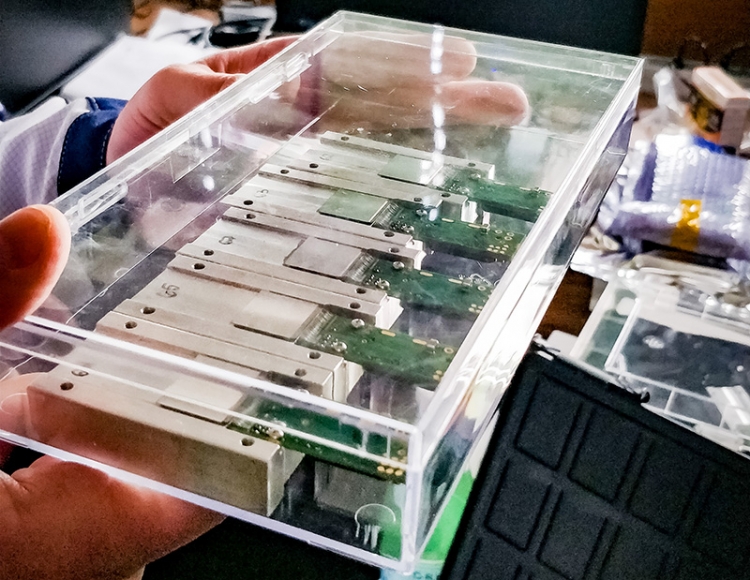
When the Large Hadron Collider is in operation, the cavern containing the CMS detector is an extremely inhospitable place, due to the high-energy radiation produced by the collisions. Even after a LHC fill finishes, some residual radioactivity can persist, which poses a potential danger to people who need to work in the cavern to fix broken equipment or install upgrades. Monitoring the radiation environment in the cavern is thus a crucial piece of ensuring that people can work safely, and a new system for this purpose is being developed by the CMS BRIL (Beam Radiation, Instrumentation, and Luminosity) group using the new Medipix3RX chip, the latest of the Medipix3 chip family.
The Medipix3 chip recently made headlines for being used in a new 3D scanner to take color X-rays. The Medipix collaboration originated at CERN to develop a chip for medical imaging using pixel technology, but both the ATLAS and CMS experiments realized that the chip had great potential for use in high-energy physics as well. The University of Canterbury, one of the members of the Medipix collaboration and one of the principal institutions developing Medipix applications for medical technology, is also an active participant in CMS and has led the effort to employ this technology in the radiation monitoring field.
Silicon pixel detector technology has been a centerpiece of the experiments at the LHC since their inception, and Medipix continued this development to explore uses of this technology in other fields. The Medipix chips combine the pixels with an electronic shutter, so that the number of particles reaching the pixels when the shutter is open can be very precisely determined. Now, the technology has come full circle by being used again at CMS.
Medipix “is a new thing for the CMS experiment,” said Srinidhi Bheesette, a student at the University of Canterbury involved in the project. The technology was originally tested during the first run of the LHC from 2010 to 2012, installing the previous-generation Medipix2 in the CMS cavern, “and the results were positive so the technology was approved for further testing.” The current planned setup involves a total of 7 different locations in the CMS cavern, each with two detectors consisting of a Medipix3 chip with a neutron conversion layer. The two detectors at each location use different materials for the neutron conversion layer so that they can detect neutrons with different energies produced by radioactivity in the cavern. Four of the detectors were installed in two locations in March, and four more detectors in the technical stop in September, with plans to install the remainder after the end of the 2018 run. Since simulations are also used extensively to model the radiation environment, the chip installations can be used to verify and validate these simulations as well.
In addition to the Medipix chip, the BRIL group also plans to test another chip produced by the Medipix collaboration, Timepix3, which measures not only the total amount of radiation but also is able to provide precise time information. “With Timepix3, it can be used for neutron spectrometry using the time of flight,” said Arkady Lokhovitskiy, an engineer with the University of Canterbury. Neutron spectrometry measures the energy of the neutrons, helping us to understand their source and potential danger. The group hopes to install the Timepix3-based detectors during the next CERN shutdown period in 2019-2020 to be ready for the following LHC run.
Given the complexity and difficulty of developing such advanced technology, being able to find multiple uses for new chips like Medipix3 can save groups a great deal of time, money, and effort. The CERN Knowledge Transfer group has led the effort to license the Medipix technology to MARS Bioimaging, which is developing the applications of the chip in 3D medical scanning, and to other companies, ensuring that the chip can have many useful lives.
- Log in to post comments

